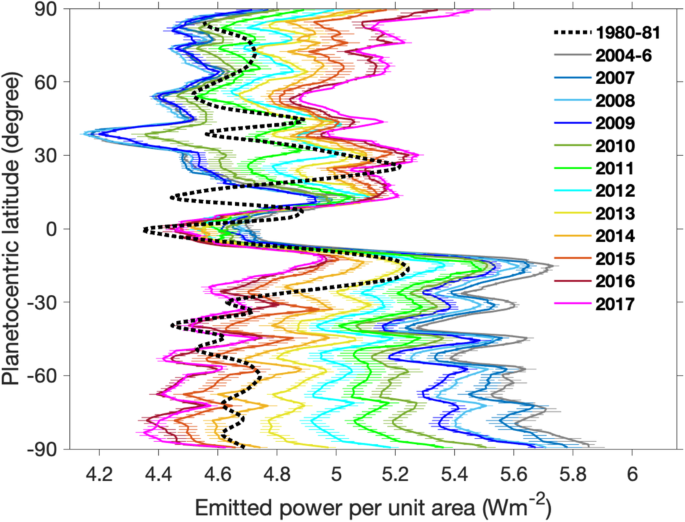2024-06-18 ヒューストン大学(UH)
<関連情報>
- https://uh.edu/news-events/stories/2024/june/06182024-saturn-energy-imbalance.php
- https://www.nature.com/articles/s41467-024-48969-9
カッシーニ探査機、土星の地球規模のエネルギー不均衡を発見 Cassini spacecraft reveals global energy imbalance of saturn
Xinyue Wang,Liming Li,Xun Jiang,Patrick M. Fry,Robert A. West,Conor A. Nixon,Larry Guan,Thishan D. Karandana G,Ronald Albright,Joshua E. Colwell,Tristan Guillot,Mark D. Hofstadter,Matthew E. Kenyon,Anthony Mallama,Santiago Perez-Hoyos,Agustin Sanchez-Lavega,Amy A. Simon,Daniel Wenkert & Xi Zhang
Nature Communications Published:18 June 2024
DOI:https://doi.org/10.1038/s41467-024-48969-9

Abstract
The global energy budget is pivotal to understanding planetary evolution and climate behaviors. Assessing the energy budget of giant planets, particularly those with large seasonal cycles, however, remains a challenge without long-term observations. Evolution models of Saturn cannot explain its estimated Bond albedo and internal heat flux, mainly because previous estimates were based on limited observations. Here, we analyze the long-term observations recorded by the Cassini spacecraft and find notably higher Bond albedo (0.41 ± 0.02) and internal heat flux (2.84 ± 0.20 Wm−2) values than previous estimates. Furthermore, Saturn’s global energy budget is not in a steady state and exhibits significant dynamical imbalances. The global radiant energy deficit at the top of the atmosphere, indicative of the planetary cooling of Saturn, reveals remarkable seasonal fluctuations with a magnitude of 16.0 ± 4.2%. Further analysis of the energy budget of the upper atmosphere including the internal heat suggests seasonal energy imbalances at both global and hemispheric scales, contributing to the development of giant convective storms on Saturn. Similar seasonal variabilities of planetary cooling and energy imbalance exist in other giant planets within and beyond the Solar System, a prospect currently overlooked in existing evolutional and atmospheric models.


